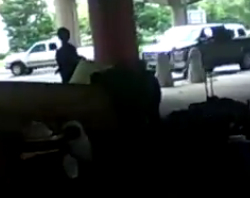 Right after Hurricane Katrina, newly homeless New Orleanians gathered on Claiborne Avenue under Interstate 10, and lived under tents and blankets. Some worked in hotels in the French Quarter and the Central Business District, but still didn’t make enough to pay for a place to live. For a time, their numbers went down. But now, six years after the storm, homeless folks are under the Claiborne Bridge, and under the Earhart Bridge, in large numbers again.
Right after Hurricane Katrina, newly homeless New Orleanians gathered on Claiborne Avenue under Interstate 10, and lived under tents and blankets. Some worked in hotels in the French Quarter and the Central Business District, but still didn’t make enough to pay for a place to live. For a time, their numbers went down. But now, six years after the storm, homeless folks are under the Claiborne Bridge, and under the Earhart Bridge, in large numbers again.